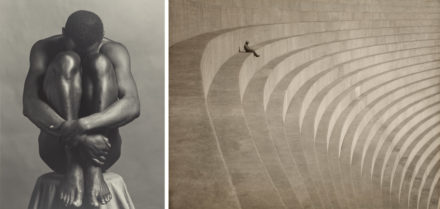
Writer Reed Johnson with, from left, filmmakers Thom Andersen and William Friedkin and film critics Richard Schickel and Kenneth Turan at “How Los Angeles Invented the World.” Image courtesy of Zocalo Public Square
Impersonal concrete sprawl. A surfer’s paradise. A dark battleground of grisly crimes. Los Angeles is a regular character in the movies, on TV, in books, and in art, but its identities are as numerous as its roles.
The recent conference How Los Angeles Invented the World took up this identity crisis, investigating the flip side of the Pacific Standard Time equation: L.A. in art, instead of art in L.A. Filmmakers, critics, historians, and writers talked about what roles the city has played—from airhead to villain—and how those role continue to shape how Angelenos see their own turf.
See the video of the panels here, courtesy of event co-organizer Zocalo Public Square, and read their summary of the discussions here.
No medium has been more powerful in shaping the image of L.A. than movies. On one of the day’s three panels, film critics Kenneth Turan and Richard Schickel chatted with directors William Friedkin and Thom Andersen, who have created portraits of the city on film. The panelists commented on L.A.’s recurring movie roles as beach bum, Hollywood starlet, and—most memorably—noir goddess. The city has been portrayed in numerous films as a dark place fraught with secrets.
Even the sunshine can sometimes seem menacing; Friedkin said the city’s “sun-bleached freeways and reflective surfaces” were exactly what he was after when making his thriller To Live and Die in L.A.
Why such a pessimistic portrait? Speakers suggested it may have to do with L.A.’s sense of impermanence, as well as its geologically unpredictable nature. “Face it: Los Angeles is an incredibly unstable place,” said Schickel. However, and luckily for us Angelenos, even that “impermanence is impermanent.”
Los Angeles, the panelists agreed, is also a city that writers and directors love to destroy (especially transplanted East Coasters). In Kiss Me Deadly, the world ends—first—in L.A. In Blade Runner, the city is the picture of environmental squalor, with ubiquitous jumbotrons and choking air. But of course, L.A. always rises again. And it can take a joke, too. Andersen, who wrote and directed Los Angeles Plays Itself, a documentary on how Los Angeles has been depicted on screen, said that Burn Hollywood Burn, a widely panned mockumentary about an over-the-top blockbuster that self-destructs, is one of his favorite movies.
Later in the day, a European perspective came from director Wim Wenders, whose dreamy films play on the friction between real and fantasy worlds. He said L.A. seemed surreal when he arrived here from Germany in 1972, comparing a drive down Mulholland Drive with a ride on a spaceship. For him, too much unreality eventually made Los Angeles unlivable.
If L.A.’s complex character is visible darkly through the scrim of the movies, so it is through the eyes of artists featured in Pacific Standard Time.
Sometimes L.A. gets a brightly lit close-up, as in Vija Celmins’ poetic 405 freeway or Garry Winogrand’s ultra-modern LAX space tower. More often, though, it emerges metaphorically, in one of its many guises. L.A.’s good air days, for example, inspired Light and Space art; its smoggy ones inspired Bruce Nauman’s L.A. Air and Ed Ruscha’s red-lit Hollywood signs. Some artworks literally incorporate parts of the city, such as Noah Purifoy’s assemblage of charrred discards from the Watts rebellion: L.A. destroyed, L.A. rising.
Perhaps the quintessential L.A. artwork is Allen Ruppersberg’s Greetings from L.A.: A Novel, which is intentionally left almost entirely blank. Is this his play on the L.A.-as-airhead stereotype? Should we all pen our own California dream?
Whether L.A. is a shiny car on an empty highway, a starlet waiting for her big break, or an ideal location for the end of the world, playing with metaphors for this messy and contradictory place is part of the fun.




Comments on this post are now closed.